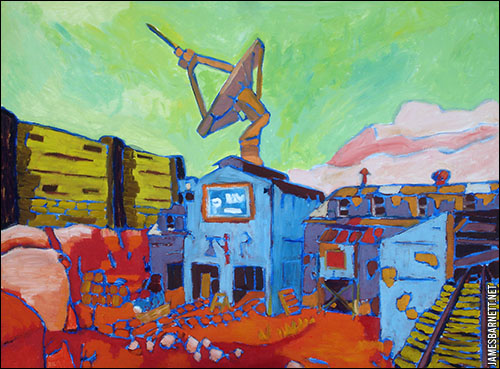
« PREVIOUS ENTRY
Why “trending topics” are so spectacularly useless
NEXT ENTRY »
The science of surviving a zombie invasion

In a few months I’m moving to a new and bigger place, and one of the best things is that I’ll finally have space to hang a new painting I bought: Goldrush, by my artist friend James Barnett. It’s part of an incredibly cool series he’s been doing: Oil paintings of scenes from video games. The piece above is called Goldrush, and the scene? It’s from Team Fortress 2.
Jamie has been doing this stuff for a while; I mentioned him in a Wired piece I wrote a year and half ago about the new generation of artists who are producing work inspired by, or meditating upon, video games. Back then he was doing work mostly from Half Life, but his latest group of paintings come from a whole array of recent games. You can see the entire series at his site here. They’re done in the lush, gobs-o-color style of the early-20th-century fauvists; Jamie calls his approach “fauxvism”, heh.
When I first saw these paintings I also was struck by their similarity to the work of the Group of Seven, a collection of modern artists who revolutionized Canadian painting in the early 20th century. The Group of Seven scandalized the staid Canadian art establishment by taking the emerging principles of modern art and applying them to the wilderness of Northern Ontario. Up until then, most Canadian art (and there wasn’t much of it) had been realist; the Group of Seven essentially crafted a new way to visualize the natural world that had become numbingly familiar to Canadians.
What I love about Jamie’s work is that it has the same sort of relationship to realism in video games. Most big-budget 3D action games these days strive after straightforward photorealism; by reinterpreting that realism fauvistically (that is probably not a word, but hey), Jamie’s paintings give you a way of re-experiencing game worlds the same way the Group of Seven’s work let early Canadians re-see the world around them. Given how much time gamers spend inside “realistic” virtual worlds, games constitute our new mental landscapes. As Jamie puts it a good Q&A interview online at NewsPlink:
Q: The video games provide you with the scenes? A: Yes, but they aren’t simple screenshots from reviews or websites. I walked around within each game until I saw a view worth taking a picture of (unfortunately, there are no “Scenic Viewpoint” signs in games). I positioned myself to create the composition from within the game, and that’s what I used as a basis for the painting.
Q: How long does the process take you? And what do you use?
A: Each one takes about 5 to 25 hours depending on size, not counting the time spent in-game stalking the elusive perfect composition. They’re all oil on wood panel.Q: Some of them seem true-to-life in that they are recognizable. Does that mean we’ve come a long way from Pac-Man?
A: We have, but I get frustrated by three-dimensional games that slavishly imitate real life. You have teams of artists and designers; why just imitate normal old reality? Come ON, people! Do something weird! Games like Braid have expanded that boundary by introducing painterly artwork. Fortunately, even some 3D games have started to move away from representational rendering into more fanciful and interesting styles.
The funny thing about Goldrush is that I haven’t actually played Team Fortress 2 yet myself, so I’m not re-experiencing the game when I look at the painting. Then again, I’m not re-experiencing the specific location in Algonquin Park when I look at Tom Thomson’s The West Wind, because I’ve never visited that spot either. I do look forward to finally playing Team Fortress 2 and visiting that radio telescope, though!
I'm Clive Thompson, the author of Smarter Than You Think: How Technology is Changing Our Minds for the Better (Penguin Press). You can order the book now at Amazon, Barnes and Noble, Powells, Indiebound, or through your local bookstore! I'm also a contributing writer for the New York Times Magazine and a columnist for Wired magazine. Email is here or ping me via the antiquated form of AOL IM (pomeranian99).

ECHO
Erik Weissengruber
Vespaboy
Terri Senft
Tom Igoe
El Rey Del Art
Morgan Noel
Maura Johnston
Cori Eckert
Heather Gold
Andrew Hearst
Chris Allbritton
Bret Dawson
Michele Tepper
Sharyn November
Gail Jaitin
Barnaby Marshall
Frankly, I'd Rather Not
The Shifted Librarian
Ryan Bigge
Nick Denton
Howard Sherman's Nuggets
Serial Deviant
Ellen McDermott
Jeff Liu
Marc Kelsey
Chris Shieh
Iron Monkey
Diversions
Rob Toole
Donut Rock City
Ross Judson
Idle Words
J-Walk Blog
The Antic Muse
Tribblescape
Little Things
Jeff Heer
Abstract Dynamics
Snark Market
Plastic Bag
Sensory Impact
Incoming Signals
MemeFirst
MemoryCard
Majikthise
Ludonauts
Boing Boing
Slashdot
Atrios
Smart Mobs
Plastic
Ludology.org
The Feature
Gizmodo
game girl
Mindjack
Techdirt Wireless News
Corante Gaming blog
Corante Social Software blog
ECHO
SciTech Daily
Arts and Letters Daily
Textually.org
BlogPulse
Robots.net
Alan Reiter's Wireless Data Weblog
Brad DeLong
Viral Marketing Blog
Gameblogs
Slashdot Games